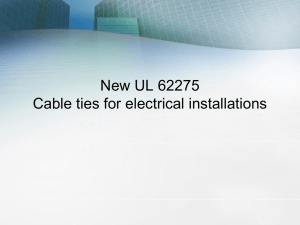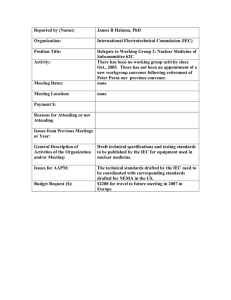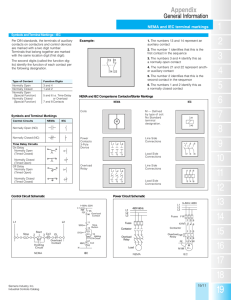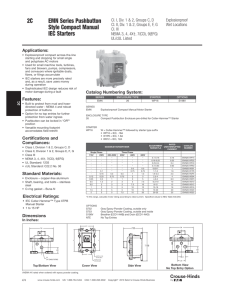IEC VS. NEMA PUSH BUTTONS A reference guide to key design
advertisement
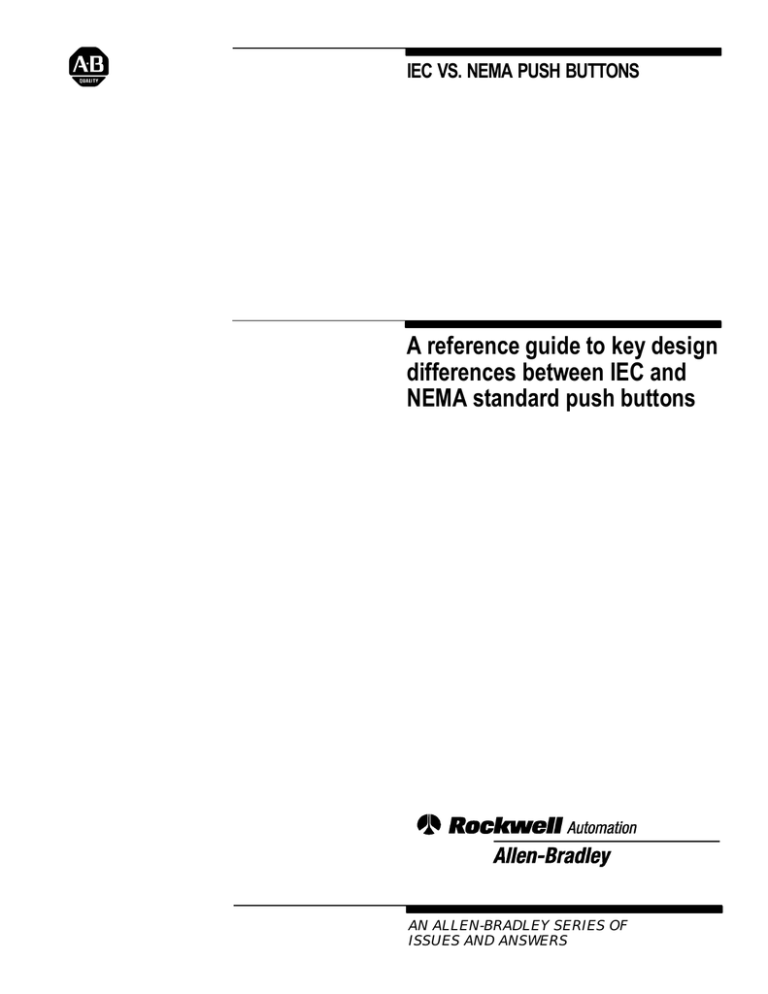
IEC VS. NEMA PUSH BUTTONS A reference guide to key design differences between IEC and NEMA standard push buttons AN ALLEN-BRADLEY SERIES OF ISSUES AND ANSWERS CONTENTS INTRODUCTION . . . . . . . . . . . . . . . . . . . . . . . . . . . . . . . 1 INGRESS PROTECTION . . . . . . . . . . . . . . . . . . . . . . . . . 1 ELECTRICAL PERFORMANCE . . . . . . . . . . . . . . . . . . . . 5 IEC ELECTRICAL RATINGS . . . . . . . . . . . . . . . . . . . . . . 5 NEMA ELECTRICAL RATINGS . . . . . . . . . . . . . . . . . . . . 5 PANEL HOLE SIZE . . . . . . . . . . . . . . . . . . . . . . . . . . . . . 8 OPERATOR STYLING . . . . . . . . . . . . . . . . . . . . . . . . . . . 8 CONSTRUCTION . . . . . . . . . . . . . . . . . . . . . . . . . . . . . . 9 ASSEMBLY AND PACKAGING . . . . . . . . . . . . . . . . . . . . 9 PANEL SEALING . . . . . . . . . . . . . . . . . . . . . . . . . . . . . 10 CONNECTION TERMINATION . . . . . . . . . . . . . . . . . . . . . 11 FINGER SAFETY . . . . . . . . . . . . . . . . . . . . . . . . . . . . . . 11 CONCLUSION . . . . . . . . . . . . . . . . . . . . . . . . . . . . . . . 12 INTRODUCTION The globalization of industrial manufacturing has resulted in a convergence of electromechanical operator interface device styling and performance standards. That convergence is evident in the design of push button products. A common misconception holds that any operator manufactured or designed in Europe is, by definition, an “IEC push button.” Another is that IEC push buttons are manufactured only in IEC countries. Neither belief is true. Conversely, not all NEMA operators are designed, manufactured, or even sold in the United States or Canada. What is factual is that the traditional target markets for IEC and NEMA rated devices were Europe and North America, respectively. An industrial operator interface device can be described by four general characteristics: ingress protection, electrical performance, panel opening size, and styling. We will consider the differences between IEC and NEMA approaches to operator design for each of those criteria in greater detail in the pages that follow. INGRESS PROTECTION Both IEC and NEMA have defined degrees of protection from ingress of solids or liquids for enclosures. IEC ingress protection (IP) and NEMA Type ratings have been extrapolated to include push button products installed in ingress rated enclosures. Push button stations including operators installed into enclosures are subject to ingress tests. Upon successful completion of ingress testing, a manufacturer will list the appropriate IP or NEMA Type rating for a given push button. IP Ratings assess a device’s ability to withstand ingress of water and solid foreign objects. Also, IP Ratings specify protection of persons against contact with live and/or moving parts. Typical NEMA Type ratings assess a device’s ability to withstand dirt, dust, water spray, salt spray, oil spray, coolant contact, rust buildup, and degrees of protection from rain, sleet, snow, ice, and corrosion. Additional information discussing similarities and differences of IP and NEMA Type tests are included in the Allen-Bradley White Paper entitled Environmental Ratings for Push Buttons (Pub. No. GI-914). The following tables summarize both IEC IP and NEMA Type ratings. Refer to the appropriate standard for detailed information. 1 IEC AND NEMA PUSHBUTTONS NEMA Type Ratings Provides a Degree of Protection Against the Following Environmental Conditions Type of Enclosure 1➀ 2➀ 4 4X 5 6 6P 11 12 Incidental contact with the enclosed equipment X X X X X X X X X X X Falling dirt X X X X X X X X X X X X X X X X X X X X Dust, lint, fibers, and flyings➁ X X X X X X X Hosedown and splashing water X X X X X X X Falling liquids and light splashing X Oil and coolant seepage 12K 13 Oil or coolant spraying and splashing X Corrosive agents X X Occasional temporary submersion X Occasional prolonged submersion X X X ➀ These enclosures may be ventilated. However, Type 1 may not provide protection against small particles of falling dirt when ventilation is provided in the enclosure top. Consult the manufacturer. ➁ These fibers and flyings are nonhazardous materials and are not considered the Class III type ignitable fibers or combustible flyings. For Class III type ignitable fibers or combustible flyings see the National Electrical Code, Section 500-6(a). Comparison of specific applications of enclosures for indoor nonhazardous locations (From NEMA Standard 1-10-1985, a copyrighted publication of the National Electrical Manufacturers Association). Provides a Degree of Protection Against the Following Environmental Conditions Type of Enclosure 3 3R➀ 3S 4 4X 6 6P Incidental contact with the enclosed equipment X X X X X X X Rain, snow, and sleet➁ X X X X X X X X X X X X X X X Sleet➂ Windblown dust Hosedown Corrosive agents X X X X Occasional temporary submersion X X Occasional prolonged submersion ➀ These enclosures may be ventilated. ➁ External operating mechanisms are not required to be operable when the enclosure is ice covered. ➂ External operating mechanisms are operable when the enclosure is ice covered. Comparison of specific applications of enclosures for outdoor nonhazardous locations (From NEMA Standard 1-10-1985, a copyrighted publication of the National Electrical Manufacturers Association). 2 IEC AND NEMA PUSHBUTTONS IEC IP Ratings First Characteristic Numeral Degree of Protection Short Description➀ Definition (See Complete Standard, Clause 3) Test Conditions (See Sub-clause) 0 Non-protected No special protection. 1 Protected against solid objects greater than 50 mm A large surface of the body, such as a hand (but no protection against deliberate access). Solid objects exceeding 50 mm in diameter. 7.1 2 Protected against solid objects greater than 12 mm Fingers or similar objects not exceeding 80 mm in length. Sold objects exceeding 12 mm in diameter. 7.2 3➁ Protected against solid objects greater than 2.5 mm Tools, wires, etc., of diameter or thickness greater than 2.5 mm. Solid objects exceeding 2.5 mm in diameter 7.3 4➁ Protected against solid objects greater than 1.0 mm Wires or strips of thickness greater than 1.0 mm. Solid objects exceeding 1.0 mm in diameter. 7.4 5➂ Dust-protected Ingress of dust is not totally prevented but dust does not enter in sufficient quantity to interfere with satisfactory operation of the equipment. 7.5 Dust-tight No ingress of dust. 7.6 6 No tests ➀ The short description given in column 2 of this table should not be used to specify the form of protection. It should only be used as a brief description. ➁ For first characteristic numerals 3 and 4, the application of this table to equipment containing drain holes or ventilating openings is the responsibility of the relevant Technical Committee. ➂ For first characteristic numeral 5, the application of this table to equipment containing drain holes is the responsibility of the relevant Technical Committee Degrees of protection indicated by the first characteristic numeral (From IEC Standard 529-1. Used with permission.). 3 IEC AND NEMA PUSHBUTTONS IEC IP Ratings Second Characteristic Numeral Degree of Protection Short Description➀ Definition (See Complete Standard, Clause 4) Test Conditions (See Sub-clause) 0 Non-protected No special protection. No tests 1 Protected against dripping water Dripping water (vertically falling drops) have no harmful effect. 8.1 2 Protected against dripping water when tilted up to 15_ Vertically dripping water shall have no harmful effect when the enclosure is tilted at any angle up to 15_ from its normal position. 8.2 3 Protected against spraying water Water falling as a spray at an angle up to 60_ from the vertical shall have no harmful effect. 8.3 4 Protected against splashing water Water splashed against the enclosure from any direction shall have no harmful effect. 8.4 5 Protected against water jets Water projected by a nozzle against the enclosure from any direction shall have no harmful effect. 8.5 6 Protected against heavy seas Water from heavy seas or water projected in powerful jets shall not enter the enclosure in harmful quantities. 8.6 7 Protected against the effects Ingress of water in a harmful quantity shall not be of submersion possible when the enclosure is immersed in water under defined conditions of pressure and time. 8.7 8 Protected against the effects The equipment is suitable for continuous of submersion submersion in water under conditions which shall be specified by the manufacturer. Note. Normally, this will mean that the equipment is hermetically sealed. However, with certain types of equipment it can mean that water can enter but only in such a manner that it produces no harmful effects. 8.8 ➀ The short description given in column 2 of this table should not be used to specify the form of protection. It should only be used as a brief description. Degrees of protection indicated by the second characteristic numeral (From IEC Standard 529-1. Used with permission.). 4 IEC AND NEMA PUSHBUTTONS ELECTRICAL PERFORMANCE In addition to ingress ratings, push buttons are subject to electrical performance standards. Both IEC and NEMA rated devices must successfully pass tests as described in IEC 947-5-1 and NEMA ICS 5, Part I. Both standards have significant overlap of performance criteria. For example, each specifies continuous current, voltage, and contact make and break energy. Since there is considerable overlap of IEC and NEMA contact ratings, many push button manufacturers will dual-rate a device by both IEC and NEMA electrical standards for AC and DC operation. IEC ELECTRICAL RATINGS IEC 947-5-1 defines rated operational current, voltage, and power factors for make and break conditions. Values are given for both AC and DC contacts under normal and abnormal conditions. NEMA ELECTRICAL RATINGS NEMA ICS 5, Part I classifies the electrical performance of contacts based upon the results of continuous test thermal current capacity, maximum current, and make and break Volt-ampere ratings. The AC and DC contact rating designations are given in the tables that follow. NEMA ratings establish maximum contact performance. A contact manufacturer should be consulted for minimum energy level performance, since neither IEC nor NEMA standards consider this potentially important variable. 5 6 Examples of contact rating designation based on utilization categories. (From IEC 947-5-1 Used with permission.) Utilization Category AC Rated Operational Current Ie(A) at Rated Operational Voltages Ue Conventional Thermal Current Ithe(A) 120 V 240 V 380 V 480 V 500 V 600 V Make Break VA Rating A150 AC-15 10.0 6.0 – – – – – 7200 720 A300 AC-15 10.0 6.0 3.0 – – – – 7200 720 A600 AC-15 10.0 6.0 3.0 1.9 1.5 1.4 1.2 7200 720 B150 AC-15 5.0 3.0 – – – – – 3600 360 B300 AC-15 5.0 3.0 1.5 – – – – 3600 360 B600 AC-15 5.0 3.0 1.5 0.95 0.75 0.72 0.6 3600 360 C150 AC-15 2.5 1.5 – – – – – 1800 180 C300 AC-15 2.5 1.5 0.75 – – – – 1800 180 C600 AC-15 2.5 1.5 0.75 0.47 0.375 0.35 0.3 1800 180 D150 AC-14 1.0 0.6 – – – – – 432 72 D300 AC-14 1.0 0.6 0.3 – – – – 432 72 E150 AC-14 0.5 0.3 – – – – – 216 36 125 V 250 V 440 V 500 V 600 V DC N150 DC-13 10.0 2.2 – – – – 275 275 N300 DC-13 10.0 2.2 1.1 – – – 275 275 N600 DC-13 10.0 2.2 1.1 0.63 0.55 0.4 275 275 P150 DC-13 5.0 1.1 – – – – 138 138 P300 DC-13 5.0 1.1 0.55 – – – 138 138 P600 DC-13 5.0 1.1 0.55 0.31 0.27 0.2 138 138 Q150 DC-13 2.5 0.55 – – – – 69 69 Q300 DC-13 2.5 0.55 0.27 – – – 69 69 Q600 DC-13 2.5 0.55 0.27 0.15 0.13 0.1 69 69 R150 DC-13 1.0 0.22 – – – – 28 28 R300 DC-13 1.0 0.22 0.1 – – – 28 28 ➀ The letter stands for the conventional thermal current, and identifies AC. or DC For example, B is 5 Amps AC. The following numbers are the rated insulated voltage. IEC AND NEMA PUSHBUTTONS Designation➀ IEC AND NEMA PUSHBUTTONS Maximum Current (Amperes) Voltamperes A150 Thermal Continuous Test Current (Amperes) 10.0 A300 10.0 60.0 6,000 30 3.00 – – – – 7,200 720 A600 10.0 60.0 6,000 30 3.00 15 1.5 12 1.20 7,200 720 B150 5.0 30.0 3,000 – – – – – – 3,600 360 B300 5.0 30.0 3,000 15 1.50 – – – – 3,600 360 B600 5.0 30.0 3,000 15 1.50 7.5 0.75 6 0.60 3,600 360 C150 2.5 15 1.5 – – – – – – 1,800 180 C300 2.5 15 1.5 7.5 0.75 – – – – 1,800 180 C600 2.5 15 1.5 7.5 0.75 3.75 0.375 3.00 0..30 1,800 180 D150 1.0 3.60 0..60 – – – – – – 432 72 D300 1.0 3.60 0.60 1.80 0.30 – – – – 432 72 E150 0.5 1.80 0.30 – – – – – – 216 36 NEMA Contact Rating Designation 120 V 240 V 480 V 600 V Make Break – 7,200 720 Make Break Make Break Make Break Make Break 60.0 6,000 – – – – – Ratings and test values for AC control circuit contacts at 50 or 60 Hertz (From NEMA Standard ICS 5-1994, Part 1, a copyrighted publication of the National Electrical Manufacturers Association). NEMA Contact Rating Designation Thermal Continuous Test Current (Amperes) 125 V 250 V 301-600 V Make or Break at 300 V or Less, Voltamperes N150 10.0 2.2 – – 275 N300 10.0 2.2 1.1 – 275 N600 10.0 2.2 1.1 0.40 275 P150 5.0 1.1 – – 138 P300 5.0 1.1 0.55 – 138 P600 5.0 1.1 0.55 0.20 138 Q150 2.5 0.55 – – 69 Q300 2.5 0.55 0.27 – 69 Q600 2.5 0.55 0.27 0.10 69 R150 1.0 0.22 – – 28 R300 1.0 0.22 0.11 – 28 Maximum Make or Break Current (Amperes) Ratings and test values for DC control circuit contacts. (From NEMA Standard ICS 5-1994, Part 1, a copyrighted publication of the National Electrical Manufacturers Association). 7 IEC AND NEMA PUSHBUTTONS PANEL HOLE SIZE Industrial push buttons have three standard panel opening sizes: 16 mm, 22.5 mm, and 30.5 mm. The 16 mm and 22.5 mm conventions originated in Europe, and the 30.5 mm size gained popularity in North America. Today, all sizes enjoy global acceptance. Hole size is specified by IEC standards, but not by NEMA standards. The advantage of a 22.5 or 16 mm operator is its compact size. A panel space savings often results from a small operator’s reduced spacing requirements. A continuing trend to downsize available panel area has led to increased use of 22.5 mm and 16 mm operators instead of 30.5 mm units. On the other hand, 30.5 mm operators offer a larger package for enclosing additional internal components. A common perception is that a larger 30.5 mm push button is more rugged than a 22.5 mm one. The greater percentage of metallic components common in larger push buttons often supports this view. However, ruggedness is not solely indicated by hole size, and there is an overlap in the ruggedness of 22.5 mm and 30.5 mm devices. Size Mounting Hole Diameter d (mm) )0.5 0 Key Recess (if any) Height h (mm) 33.0 Width b (mm) )0.5 0 4.8 )0.20 D30 30.5 D22 22.3 )0.40 24.1 )0.40 3.2 )0.20 D16 16.2 )0.20 17.9 )0.20 1.7 )0.20 D12 12.1 )0.20 13.8 )0.20 1.7 )0.20 Mounting hole diameter and dimensions of the key recess (if any). (From IEC 947-5-1 Used with permission.) OPERATOR STYLING There are no specific IEC or NEMA standards governing operator styling. As a result, many of the characteristic features of a push button reflect nothing more than a manufacturer or customer’s preferences. Examples of a variety of styles appear in the accompanying figure. 8

